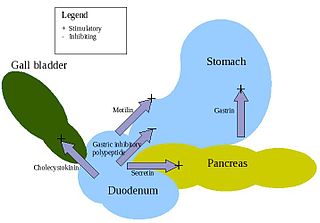
Incretins are a group of metabolic hormones that stimulate a decrease in blood glucose levels. Incretins are released after eating and augment the secretion of insulin released from pancreatic beta cells of the islets of Langerhans by a blood glucose-dependent mechanism.

Gastric inhibitory polypeptide (GIP) or gastroinhibitory peptide, also known as the glucose-dependent insulinotropic peptide, is an inhibiting hormone of the secretin family of hormones. While it is weak inhibitor of gastric acid secretion, its main role is to stimulate insulin secretion.
Proglucagon is a protein that is cleaved from preproglucagon. Preproglucagon in humans is encoded by the GCG gene.

Peptide YY (PYY) also known as peptide tyrosine tyrosine is a peptide that in humans is encoded by the PYY gene. Peptide YY is a short peptide released from cells in the ileum and colon in response to feeding. In the blood, gut, and other elements of periphery, PYY acts to reduce appetite; similarly, when injected directly into the central nervous system, PYY is also anorexigenic, i.e., it reduces appetite.

The glucagon receptor is a 62 kDa protein that is activated by glucagon and is a member of the class B G-protein coupled family of receptors, coupled to G alpha i, Gs and to a lesser extent G alpha q. Stimulation of the receptor results in activation of adenylate cyclase and increased levels of intracellular cAMP. In humans, the glucagon receptor is encoded by the GCGR gene.

Enteroendocrine cells are specialized cells of the gastrointestinal tract and pancreas with endocrine function. They produce gastrointestinal hormones or peptides in response to various stimuli and release them into the bloodstream for systemic effect, diffuse them as local messengers, or transmit them to the enteric nervous system to activate nervous responses. Enteroendocrine cells of the intestine are the most numerous endocrine cells of the body. They constitute an enteric endocrine system as a subset of the endocrine system just as the enteric nervous system is a subset of the nervous system. In a sense they are known to act as chemoreceptors, initiating digestive actions and detecting harmful substances and initiating protective responses. Enteroendocrine cells are located in the stomach, in the intestine and in the pancreas.

The glucagon-like peptide-1 receptor (GLP1R) is a receptor protein found on beta cells of the pancreas. It is involved in the control of blood sugar level by enhancing insulin secretion. In humans it is synthesised by the gene GLP1R, which is present on chromosome 6. It is a member of the glucagon receptor family of G protein-coupled receptors. GLP1R is composed of two domains, one extracellular (ECD) that binds the C-terminal helix of GLP-1, and one transmembrane (TMD) domain that binds the N-terminal region of GLP-1. In the TMD domain there is a fulcrum of polar residues that regulates the biased signaling of the receptor while the transmembrane helical boundaries and extracellular surface are a trigger for biased agonism.

The gastric inhibitory polypeptide receptor (GIP-R), also known as the glucose-dependent insulinotropic polypeptide receptor, is a protein that in humans is encoded by the GIPR gene. GIP-R is a member of the 7-transmembrane protein family, a class of G protein–coupled receptors. GIP-R is found on beta-cells in the pancreas.
The glucagon receptor family is a group of closely related G-protein coupled receptors which include:

Vasoactive intestinal peptide receptor 2 also known as VPAC2, is a G-protein coupled receptor that in humans is encoded by the VIPR2 gene.

G protein-coupled receptor 119 also known as GPR119 is a G protein-coupled receptor that in humans is encoded by the GPR119 gene.

G-protein coupled receptor 120 is a protein that in humans is encoded by the GPR120 gene.
Secretin family receptor proteins, also known as Family B or family 2 of G-protein coupled receptors are regulated by peptide hormones from the glucagon hormone family. The family is different from adhesion G protein-coupled receptors.

Glucagon/GIP/secretin/VIP hormones are a family of evolutionarily related peptide hormones that regulate activity of G-protein coupled receptors from secretin receptor family.

Guanine nucleotide-binding protein G(t) subunit alpha-3, also known as gustducin alpha-3 chain, is a protein that in humans is encoded by the GNAT3 gene.

Daniel Joshua Drucker FRS FRCPC is a professor of medicine at the Lunenfeld-Tanenbaum Research Institute, Mount Sinai Hospital, Toronto. In 1996, Drucker first identified the proliferative effects that GLP-2 has on small bowel proliferation in rats.

Semaglutide is a pharmaceutical drug developed by Danish company Novo Nordisk. Originally developed for the treatment of type 2 diabetes in 2012, it was found in 2017 that it can be used for the treatment of obesity.






















